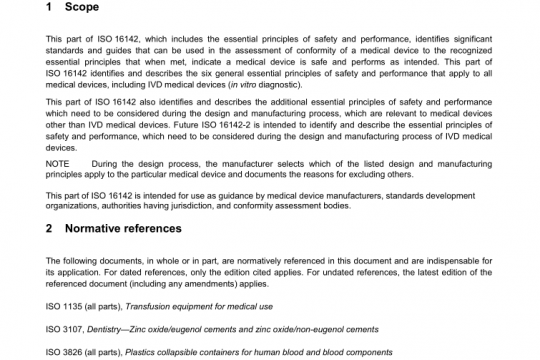AAMI TIR42 pdf free download – Evaluation of particulate associated with vascular medical devices
AAMI TIR42 pdf free download.Evaluation of particulate associated with vascular medical devices.
4 Introduction
In presentation of a medical device to patients, it is important to minimize the unintentional particulate matter present on the device or released from the device during clinical use that can interact with the patient during therapy. Extraneous particulate matter from a device has been indicated to present a safety risk to patients, in some instances, as described in Sections 8 and 9 of this document.
Due to the absence of comprehensive and definitive clinical safety data, generally accepted particulate size ranges and particulate count limits that aid patient safety have yet to be established for intravascular devices. This is due to the fact that setting specific limits is complicated by varied patient thresholds to emboli due to a broad array of medical conditions and comorbidities, the vast array of vascular beds with different sizes in the human anatomy, and the benefit(s) of the device to the patient. This TIR has not overcome this obstacle but recommends general approaches to generate limits based on benefit/risk principles. These approaches require assumptions with appropriate rationale by the device manufacturer to set particulate limits.
5 Key characteristics for evaluation of particulate
5.1 Identity
The chemical composition of particulate might be an important consideration when investigating and characterizing potential sources of the particulate matter. The identification of particulate matter is usually conducted through analytical techniques as discussed in Section 7 and Annex A below. It might be important to consider the identity (e.g., material type, chemical composition, etc.), source, and potential toxicity of each type of particulate. It is not expected that all particulate need to be identified, but efforts at identification should be undertaken when appropriate (e.g., when particulate levels have exceeded limits, large or atypical particulate, such as in color, shape, or morphology, is found, or as necessary to better derive the source of particulate).
5.2 Size
The size of particulate can be important because particulate can block blood vessels, however criticality of size might vary depending on vasculature and risk. Manufacturers should determine what sizes are appropriate based on their device considerations and the vascular area for which a device will be used. It is often useful to describe particulate size ranges (generally three or more) to quantify the number of particulate falling into these specified groupings.
5.3 Shape The shape of particulate matter can have important effects. Understanding particulate shape is important not only to determine the source, but to also understand added risks posed by the introduction of these particulate to the vascular system. For example, fibers might be a unique concern because the three dimensions will be very different (fibers are defined as having an aspect ratio of ≥ 10:1). Counting and characterization methods might not distinguish fibers in the same way, and the biological effects of fibers can be different from round particles having the same surface area or dimension. If the presence of fibers is suspected, it might be useful to employ multiple characterization methods. Appropriate methods (e.g., microscopy) should be used to characterize the shape of particulate shed by intravascular medical devices in order to ensure particulate counting methods are appropriate.
5.4 Quantity The allowable quantity of particulate matter depends on a variety of factors including chemical composition, potential toxicity, shape, and size. Particulate count limits are not recommended in this TIR because of the absence of comprehensive and definitive clinical data and the benefits of the device should be weighed with the particulate risks. See Section 9 for more detail on strategies for establishing particulate limits.AAMI TIR42 pdf download.
Other IEC Standards
-

ANSI AAMI ISO 16142-1 pdf free download – non-IVD medical devices and guidance on the selection of standards
AAMI standards list DOWNLOAD -

ANSI AAMI ISO 16142-2 pdf free download – General essential principles and additional specifc essential principles
AAMI standards list DOWNLOAD


